Structure and mechanism of B-family DNA polymerase ζ specialized for translesion DNA synthesis
- PMID: 32807989
- PMCID: PMC7554088
- DOI: 10.1038/s41594-020-0476-7
Structure and mechanism of B-family DNA polymerase ζ specialized for translesion DNA synthesis
Abstract
DNA polymerase ζ (Polζ) belongs to the same B-family as high-fidelity replicative polymerases, yet is specialized for the extension reaction in translesion DNA synthesis (TLS). Despite its importance in TLS, the structure of Polζ is unknown. We present cryo-EM structures of the Saccharomyces cerevisiae Polζ holoenzyme in the act of DNA synthesis (3.1 Å) and without DNA (4.1 Å). Polζ displays a pentameric ring-like architecture, with catalytic Rev3, accessory Pol31' Pol32 and two Rev7 subunits forming an uninterrupted daisy chain of protein-protein interactions. We also uncover the features that impose high fidelity during the nucleotide-incorporation step and those that accommodate mismatches and lesions during the extension reaction. Collectively, we decrypt the molecular underpinnings of Polζ's role in TLS and provide a framework for new cancer therapeutics.
Conflict of interest statement
Competing interests
The authors declare no competing interests.
Figures

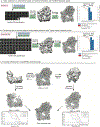
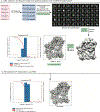
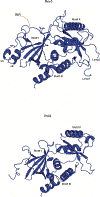

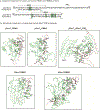
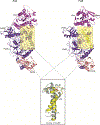
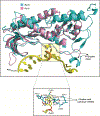
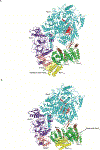
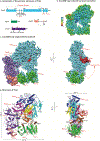
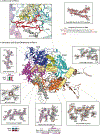
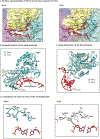
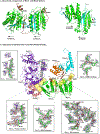
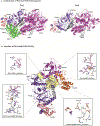
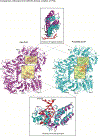
Similar articles
-
Pol31 and Pol32 subunits of yeast DNA polymerase δ are also essential subunits of DNA polymerase ζ.Proc Natl Acad Sci U S A. 2012 Jul 31;109(31):12455-60. doi: 10.1073/pnas.1206052109. Epub 2012 Jun 18. Proc Natl Acad Sci U S A. 2012. PMID: 22711820 Free PMC article.
-
The architecture of yeast DNA polymerase ζ.Cell Rep. 2013 Oct 17;5(1):79-86. doi: 10.1016/j.celrep.2013.08.046. Epub 2013 Oct 10. Cell Rep. 2013. PMID: 24120860 Free PMC article.
-
Catalytic and noncatalytic functions of DNA polymerase κ in translesion DNA synthesis.Nat Struct Mol Biol. 2025 Feb;32(2):300-314. doi: 10.1038/s41594-024-01395-3. Epub 2024 Sep 19. Nat Struct Mol Biol. 2025. PMID: 39300172 Free PMC article.
-
The Rev1-Polζ translesion synthesis mutasome: Structure, interactions and inhibition.Enzymes. 2019;45:139-181. doi: 10.1016/bs.enz.2019.07.001. Epub 2019 Aug 9. Enzymes. 2019. PMID: 31627876 Free PMC article. Review.
-
Protein Assemblies in Translesion Synthesis.Genes (Basel). 2024 Jun 24;15(7):832. doi: 10.3390/genes15070832. Genes (Basel). 2024. PMID: 39062611 Free PMC article. Review.
Cited by
-
REV1 coordinates a multi-faceted tolerance response to DNA alkylation damage and prevents chromosome shattering in Drosophila melanogaster.PLoS Genet. 2024 Jul 29;20(7):e1011181. doi: 10.1371/journal.pgen.1011181. eCollection 2024 Jul. PLoS Genet. 2024. PMID: 39074150 Free PMC article.
-
MAD2L2 dimerization and TRIP13 control shieldin activity in DNA repair.Nat Commun. 2021 Sep 14;12(1):5421. doi: 10.1038/s41467-021-25724-y. Nat Commun. 2021. PMID: 34521823 Free PMC article.
-
POLD3 as Controller of Replicative DNA Repair.Int J Mol Sci. 2024 Nov 19;25(22):12417. doi: 10.3390/ijms252212417. Int J Mol Sci. 2024. PMID: 39596481 Free PMC article. Review.
-
Molecular mechanisms of assembly and TRIP13-mediated remodeling of the human Shieldin complex.Proc Natl Acad Sci U S A. 2021 Feb 23;118(8):e2024512118. doi: 10.1073/pnas.2024512118. Proc Natl Acad Sci U S A. 2021. PMID: 33597306 Free PMC article.
-
Oxaliplatin promotes siMAD2L2‑induced apoptosis in colon cancer cells.Mol Med Rep. 2021 Sep;24(3):629. doi: 10.3892/mmr.2021.12268. Epub 2021 Jul 19. Mol Med Rep. 2021. PMID: 34278473 Free PMC article.
References
-
- Prakash S, Johnson RE & Prakash L Eukaryotic translesion synthesis DNA polymerases: specificity of structure and function. Annu Rev Biochem 74, 317–353 (2005). - PubMed
-
- Jain R, Aggarwal AK & Rechkoblit O Eukaryotic DNA polymerases. Curr Opin Struct Biol 53, 77–87 (2018). - PubMed
-
- Johnson RE, Washington MT, Haracska L, Prakash S & Prakash L Eukaryotic polymerases iota and zeta act sequentially to bypass DNA lesions. Nature 406, 1015–1019 (2000). - PubMed
Publication types
MeSH terms
Substances
Grants and funding
LinkOut - more resources
Full Text Sources
Other Literature Sources
Molecular Biology Databases
Miscellaneous

